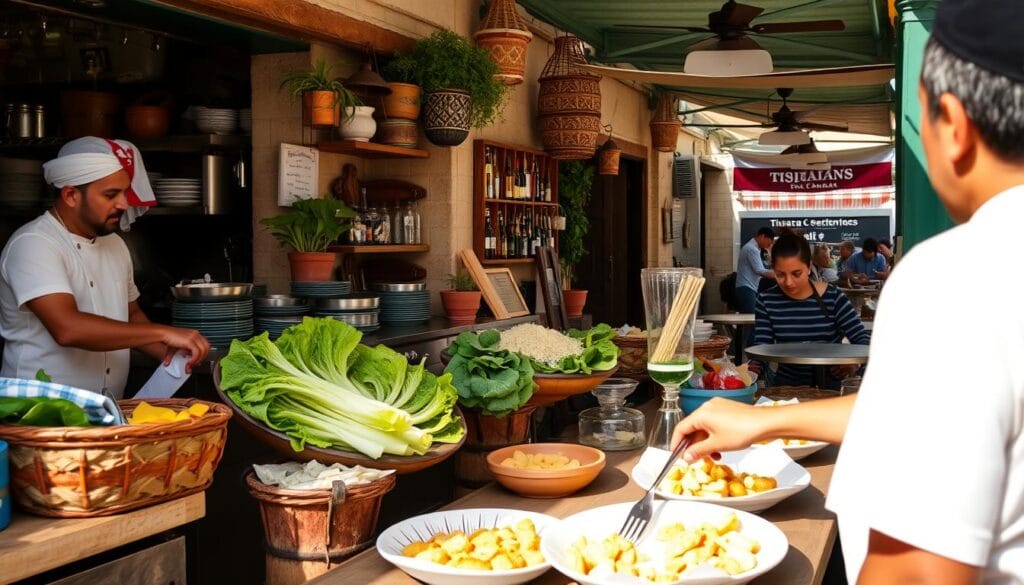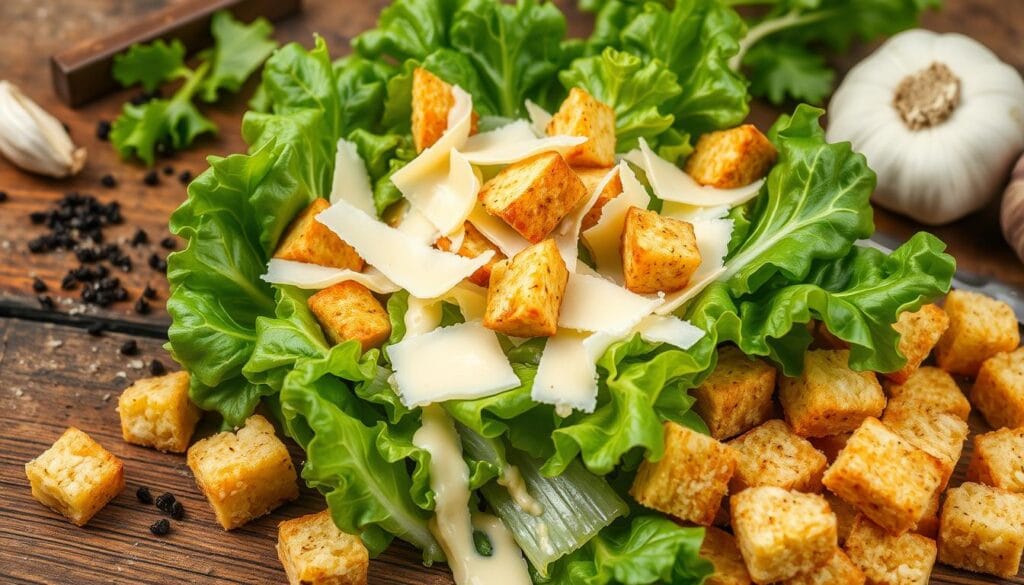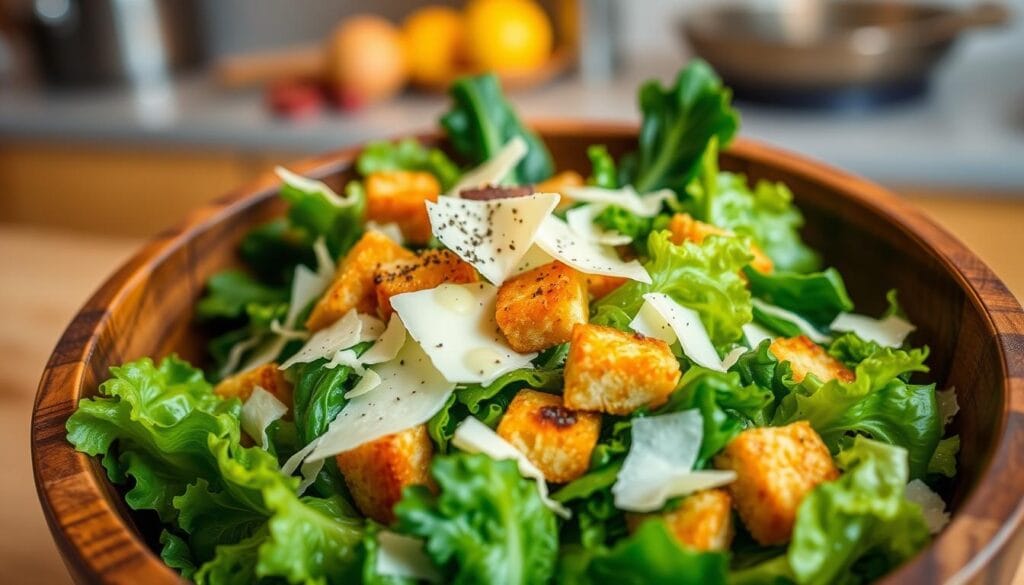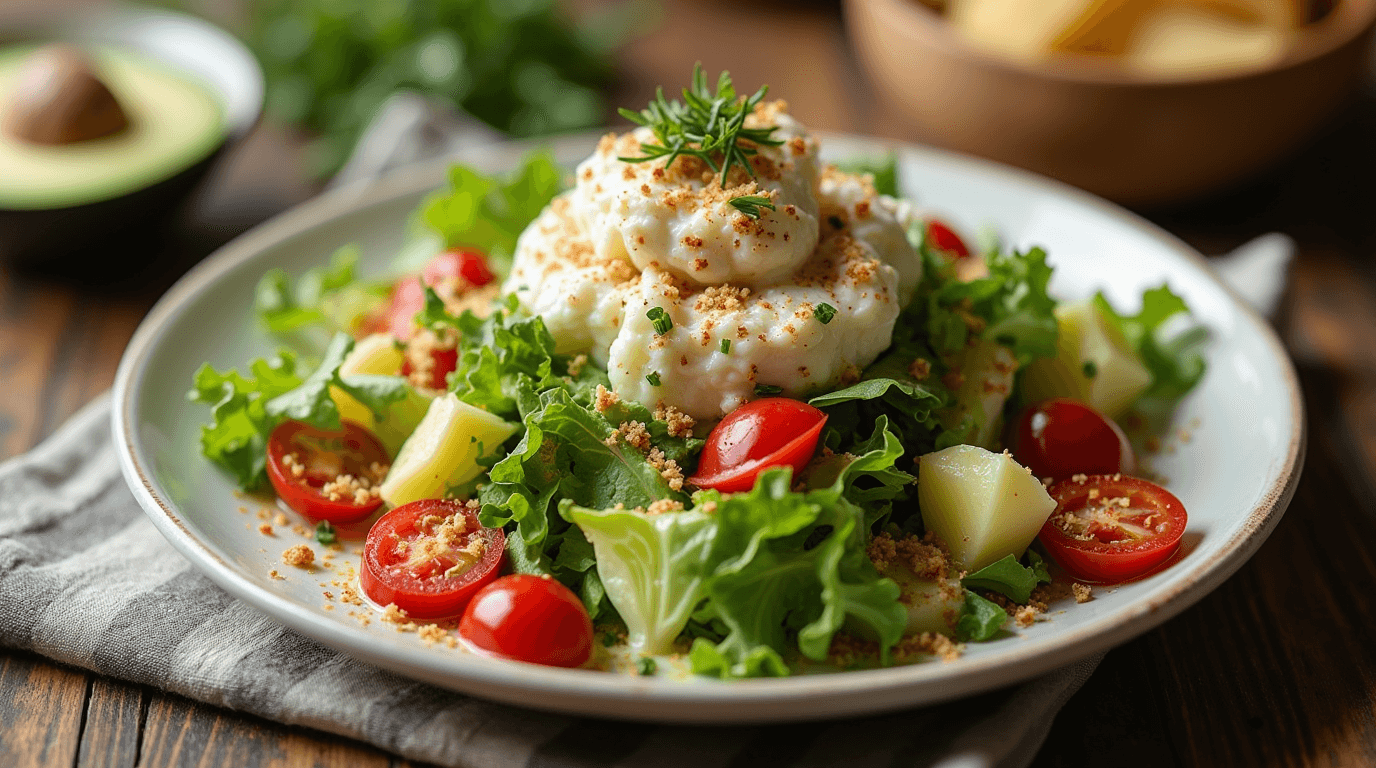Delicious Caesar Salad: Crisp Romaine, Parmesan & Croutons
Every time I slice through a crisp romaine lettuce leaf, I’m taken back to my first Caesar salad experience. It was a warm summer evening at a small family restaurant. The vibrant flavors danced across my palate, creating a culinary memory that would last a lifetime.
This salad isn’t just a dish – it’s a culinary journey that has captivated food lovers since the 1920s. From its humble origins to becoming a global restaurant staple, this salad represents a perfect harmony of textures and flavors. The combination of crisp romaine lettuce, rich Parmesan cheese, and crunchy croutons creates a symphony of taste that continues to delight diners worldwide.
Whether you’re a home cook or a restaurant enthusiast, this salad offers something special for everyone. Its versatility allows for endless variations, making it a timeless favorite that adapts to different tastes and dietary preferences.
Table of Contents
Key Takeaways
- Caesar salad originated in the 1920s
- Combines crisp romaine lettuce with classic ingredients
- Versatile dish suitable for multiple dietary needs
- Can be prepared as a side or main course
- Simple yet sophisticated culinary experience
A Brief History of the Classic Caesar-Salad
This salad has a rich history that spans nearly a century. It was born in Tijuana, Mexico, in 1924. This moment of culinary creativity changed the world of salads forever.

Origins in 1920s Tijuana
Italian immigrant Caesar Cardini created the Caesar-salad in his restaurant. Interestingly, the original Caesar-salad did not have anchovy dressing or croutons. It was meant to be a finger food, not the salad we know today.
“The salad was originally served with baby leaves as natural scoops, encouraging diners to enjoy it in a uniquely interactive way.”
Evolution into a Global Restaurant Staple
The Caesar salad quickly became a hit around the world. Here are some interesting facts:
- Approximately 35% of U.S. restaurants now feature Caesar-salad
- Nearly 43 million bottles of Caesar-salad dressing are sold annually
- The recipe first appeared in the “Joy of Cooking” cookbook in 1951
Traditional vs Modern Preparations
| Traditional Preparation | Modern Variations |
|---|---|
| Tableside preparation | Creative ingredient additions |
| No anchovies | Boquerones or salt-cured anchovies |
| Simple romaine base | Ingredients like bacon, kale, smoked trout |
Today, the Caesar-salad inspires chefs everywhere. It shows how a simple dish can become a classic.
Essential Ingredients for the Perfect Caesar Salad
To make a real Caesar-salad, you need the right ingredients. They must work together for a memorable taste. Let’s explore what makes this salad so special.
The base of a great Caesar-salad is crisp romaine lettuce. Choose fresh, vibrant romaine hearts for a crunchy texture and clean taste. Make sure to wash and dry each leaf well for the best flavor and texture.
- Fresh romaine lettuce (2 hearts)
- High-quality Parmesan cheese
- Homemade croutons
- Egg yolk-based dressing
Parmesan cheese is key to the salad’s taste. Go for freshly grated Parmesan for a rich, nutty flavor. Grate it yourself from a block for the best taste and texture.
Croutons make the salad stand out. While you can buy them, homemade ones taste better and are crunchier. Cut day-old bread into ½-inch cubes, toss with olive oil, and bake at 350°F for 10-15 minutes until golden.
“The magic of a Caesar-salad lies in its simplicity and the quality of its ingredients.” – Culinary Experts
The egg yolk is the dressing’s secret. It makes the dressing creamy and smooth. Use pasteurized egg yolks for safety. This ingredient helps mix the dressing’s ingredients into a rich, creamy sauce.
| Ingredient | Quantity | Purpose |
|---|---|---|
| Romaine Lettuce | 2 hearts | Crisp base of salad |
| Parmesan Cheese | ½ cup, freshly grated | Rich, nutty flavor |
| Croutons | 4 cups | Crunchy texture |
| Egg Yolks | 2 large | Creamy dressing base |
Mastering Homemade Caesar Dressing

Making the perfect Caesar dressing is all about precision and knowing your ingredients. With a few simple steps, you can turn a basic salad into a gourmet dish.
Key Components for Rich Flavor
A great Caesar dressing starts with top-notch ingredients. You’ll need:
- Fresh garlic (3 cloves)
- Extra-virgin olive oil (1 cup)
- Fresh lemon juice (2 tablespoons)
- Anchovy fillets (6 olive oil-packed)
- White balsamic vinegar (2 tablespoons)
Tips for Perfect Emulsification
To get a smooth Caesar dressing, follow these steps:
- Blend garlic and anchovies for 15 seconds
- Add the rest of the ingredients
- Process for another 15 seconds
- Add 2-4 tablespoons of water to adjust the consistency
Storage and Shelf Life
Keep your homemade Caesar dressing in the fridge for up to 2 weeks. It makes about 2 2/3 cups, enough for several salads.
“The secret to a great Caesar dressing is balancing flavors and achieving a smooth, creamy texture.”
| Ingredient | Quantity | Purpose |
|---|---|---|
| Garlic | 3 cloves | Adds sharp, aromatic flavor |
| Olive Oil | 1 cup | Creates smooth emulsion |
| Lemon Juice | 2 tablespoons | Provides bright, tangy notes |
| Anchovies | 6 fillets | Introduces umami depth |
For an outstanding Caesar dressing, use fresh ingredients and perfect the emulsification technique.
Creating Crispy Homemade Croutons
Turn regular bread into golden, crunchy croutons that make your Caesar-salad amazing. Making your own croutons is simple and tastes better than store-bought ones.
First, pick the right bread. Day-old bread is best for crispy croutons. Cut it into 1-inch cubes for even baking. Pro tip: Aim for cubes around 3/4 inch thick for the perfect texture.
- Choose a sturdy bread like sourdough or French bread
- Use a sharp knife for clean, precise cuts
- Ensure cubes are roughly the same size
The key to perfect croutons is the olive oil coating. Drizzle 2-3 tablespoons of extra virgin olive oil over your bread cubes. Make sure each piece is evenly covered. Sprinkle with seasonings like:
- 1 teaspoon dried parsley
- 1 teaspoon garlic powder
- 1 teaspoon mustard powder
- Fine salt to taste
Bake your croutons at 400°F for 15-18 minutes. Toss every 5 minutes to get a uniform golden-brown color. You’ll get about 4 cups of crispy, flavorful croutons that will make your Caesar salad unforgettable.
“Homemade croutons are like the exclamation point at the end of a delicious salad sentence.” – Culinary Expert
Storage tip: Store your freshly made croutons in an airtight container. They’ll stay crisp for up to a week in the fridge. They’re ready to add crunch to salads or soups whenever you need them.
Caesar Salad
Making a great salad is an art. It starts with picking the right ingredients. You need to know how to turn simple romaine lettuce into a dish that’s truly special.
Preparing Fresh Romaine Lettuce
Choosing the right romaine lettuce is key for a real Caesar-salad. Here’s how to get it ready:
- Wash romaine lettuce under cold water
- Pat dry with clean towels
- Remove tough outer leaves
- Tear into small pieces, not cutting
- Chill for 15-20 minutes before you start
Proper Assembly Technique
The secret to a top Caesar-salad is in how you put it together. Technique is as important as ingredients. Start by lightly coating your lettuce with dressing. Make sure every leaf gets a bit of dressing.
“A great Caesar-salad is about balance and precision” – Culinary Experts
Serving Temperature Guidelines
The temperature of your Caesar-salad is crucial. Keep your lettuce and ingredients cool but not cold. Serve right after dressing to keep it crisp and flavorful.
- Refrigerate ingredients before you start
- Dress the salad just before serving
- Try to serve it cool and crisp
The Art of Parmesan Selection and Preparation
Choosing the right parmesan cheese can make your Caesar-salad amazing. Not all parmesan cheeses are the same. Knowing how to pick and prepare this key ingredient is crucial.
Parmigiano Reggiano is the top choice for Caesar-salad. It adds a rich, complex flavor. Make sure to find wheels with a special stamp showing they’re from Italy.
“A great Caesar salad begins with exceptional parmesan cheese” – Culinary Experts
Parmesan Selection Criteria
- Aged a minimum of 12 months
- Nutty, robust flavor profile
- Granular, crumbly texture
- Protected Designation of Origin (PDO) certification
Preparation Techniques
- Always grate parmesan cheese fresh
- Use a microplane or fine grater
- Store in an airtight container
- Keep refrigerated but not excessively cold
| Parmesan Type | Aging Period | Flavor Intensity |
|---|---|---|
| Young Parmesan | 12-18 months | Mild |
| Mature Parmesan | 24-36 months | Sharp |
| Parmigiano Reggiano | 36+ months | Extremely Complex |
Quality parmesan cheese adds flavor and nutrition to your Caesar-salad. It has about 38 grams of protein per 100 grams. Good parmesan cheese is worth the investment for your taste buds!
Creative Variations and Modern Twists
Your classic Caesar-salad doesn’t have to be boring. Modern chefs have turned this dish into a canvas for endless variations. These changes cater to different tastes and diets.
Protein Addition Options
Make your Caesar-salad more exciting by adding protein. Here are some tasty options:
- Grilled chicken (6-9 oz per serving)
- Seared shrimp
- Baked salmon
- Crispy tofu
Vegetarian Adaptations
For those who don’t eat traditional Caesar-salad ingredients, there are creative alternatives. These keep the dish’s flavor but offer new twists:
- Replace anchovies with kalamata olives
- Use nutritional yeast instead of Parmesan
- Substitute egg-based dressing with cashew cream
Seasonal Ingredient Variations
Keep your Caesar-salad fresh by adding seasonal ingredients. They bring new flavors and freshness:
| Season | Suggested Additions |
|---|---|
| Spring | Asparagus, radishes |
| Summer | Grilled peaches, cherry tomatoes |
| Fall | Roasted butternut squash, crispy sage |
| Winter | Roasted brussels sprouts, pomegranate seeds |
Try these creative variations to turn your Caesar-salad into a culinary journey. It will be a hit with everyone.

Tips for Restaurant-Quality Presentation
Making a stunning Caesar-salad is more than just mixing ingredients. Your presentation can turn a simple salad into a masterpiece that pleases both the eyes and taste buds.
Professional chefs know that how a salad looks is key. The right way to plate can make your romaine lettuce, parmesan cheese, and croutons look amazing.
“Presentation is the first taste a diner experiences before taking a single bite.” – Culinary Experts
- Choose the right plate: Opt for minimalistic white or ceramic dishes that showcase the vibrant green romaine lettuce
- Create height and dimension with carefully arranged whole romaine leaves
- Use large, elegant parmesan cheese shavings as a dramatic garnish
- Strategically place crispy croutons for textural contrast
How you place your Caesar-salad matters a lot. Asymmetrical arrangements add interest, while negative space keeps things simple and elegant.
| Plating Material | Best Suited For |
|---|---|
| Glass Plates | Revealing layered salad complexity |
| Ceramic Dishes | Versatile and complementary to most salads |
| Wooden Platters | Rustic, hearty salad presentations |
A well-presented Caesar-salad is more than just a pretty face. It’s about creating an experience that touches all your senses.
Conclusion
Your journey into the Caesar-salad shows a deep history starting in 1920s Tijuana. Cesare Cardini’s recipe was a game-changer. It’s more than a salad; it’s a story of creativity and change.
Now, you can make the perfect Caesar-salad at home. Learn to make croutons, master the anchovy dressing, and pick the best ingredients. This turns a simple meal into a gourmet experience. It’s all about the right mix of flavors and textures.
The Caesar-salad’s charm comes from making it and sharing it. Try new things, add your own flair, and explore flavors. Your homemade Caesar salad can be a delicious mix of tradition and your own creativity. It’s perfect for any meal.
We encourage you to share your Caesar salad stories. Post a photo, try something new, and join others who love this classic dish. Let’s celebrate its lasting appeal together.
FAQ
What makes a traditional Caesar salad different from modern variations?
Traditional Caesar salads have a dressing made with raw egg yolk and anchovies. They were made tableside at Caesar Cardini’s restaurant in Tijuana. Today, many recipes have changed to make them safer or to fit different tastes. This includes using pasteurized eggs and adjusting the anchovy amount.
Can I make a Caesar salad without anchovies?
Yes, you can make a Caesar salad without anchovies. You can use Worcestershire sauce, miso paste, or capers to get that umami taste. Many places now offer anchovy-free Caesar salads for those with dietary restrictions.
Is it safe to use raw egg yolk in Caesar dressing?
Using raw egg yolk in Caesar dressing can be risky. To be safer, you can use pasteurized eggs or alternatives like mayonnaise. Cooking the egg yolk briefly is another option. Always check the latest food safety advice if you’re worried about raw eggs.
What type of bread works best for homemade croutons?
The best bread for croutons is day-old, crusty bread. Sourdough or French bread is perfect. Soft bread won’t work as well. The bread should be firm and dense for the best texture.
How long can I store homemade Caesar dressing?
Homemade Caesar dressing can last 3-5 days in the fridge. If it has raw egg, use it within 2-3 days. Always check for spoilage and keep it cold.
What are some protein additions for Caesar salad?
You can add grilled chicken, shrimp, salmon, hard-boiled eggs, or tofu for a vegetarian option. These add protein and make the salad a full meal. They also enhance the flavors of the dressing and croutons.
How do I prevent my Caesar salad from becoming soggy?
To keep your Caesar salad crisp, dry the lettuce well. Add the dressing just before serving. Use fresh croutons. Serve immediately to avoid wilting.
What’s the best way to grate Parmesan for Caesar salad?
Use a microplane or fine grater for the best Parmesan shavings. Avoid pre-grated cheese. Grate the cheese just before serving for the best flavor and texture.
How Was It?
There are no reviews yet. Be the first one to write one.

